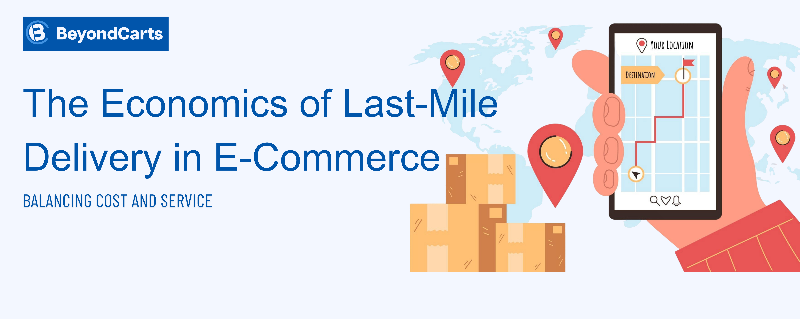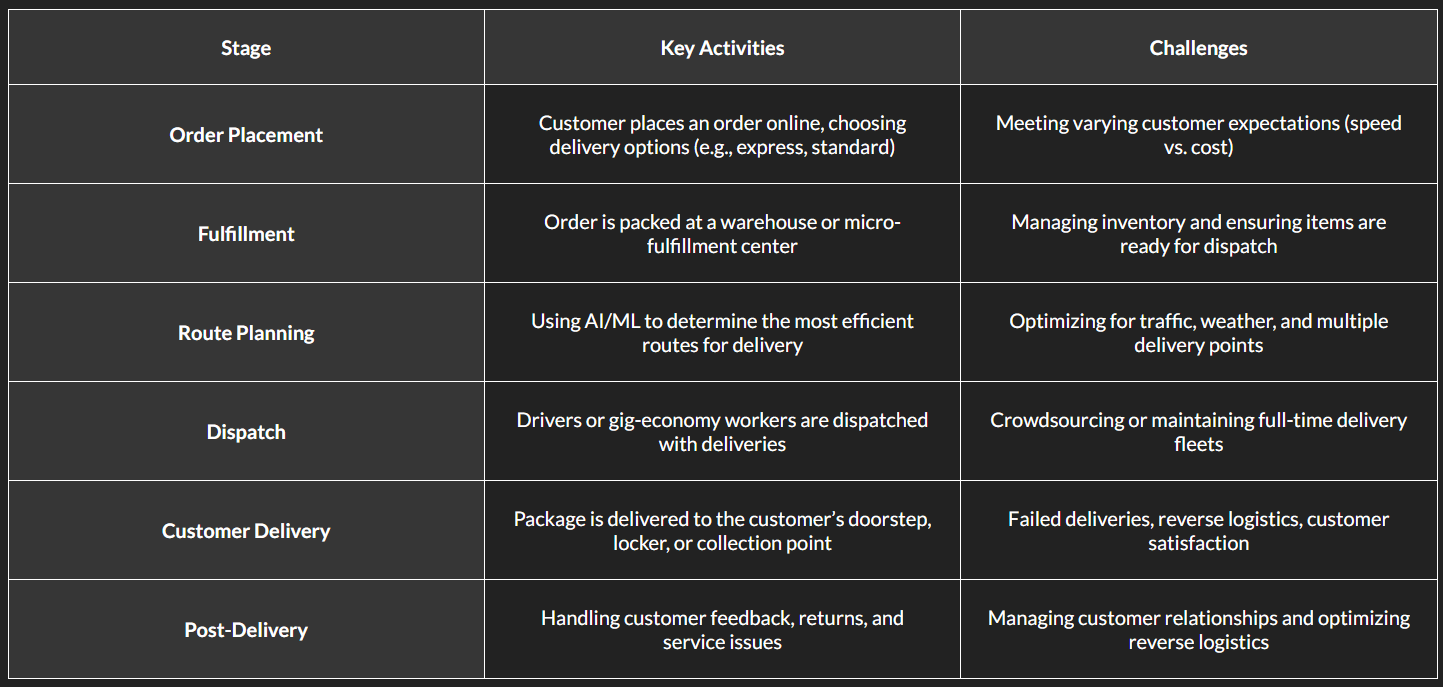
The last mile delivery is the longest, hardest and the most expensive and it can quickly erode into your profits. With the 2024 e-commerce boom, this struggle has become more pressing than ever.
Today’s consumers expect not just speed, but precision, convenience, and flexibility in delivery all at once. This shift is accelerating the cost of last-mile delivery, the last leg of getting a product from a warehouse to the customer’s door, which now accounts for 53% of total shipping costs in e-commerce. Yet, balancing these costs with exceptional service is a necessity as a basis to survive in 2024’s hyper-competitive e-commerce landscape.
What is Last-Mile Delivery?
Last-mile delivery refers to the final stretch in the logistics process where a product is transported from a warehouse or distribution center to the customer's doorstep. As the last leg of the supply chain, it plays a critical role in ensuring customer satisfaction.
This step typically involves delivering individual packages to residential addresses or retail stores and is often considered the most expensive and time-consuming part of the delivery process. Delivering individual packages to multiple destinations, often in congested urban areas or scattered rural locations, makes last-mile delivery both logistically complex and costly.
Challenges of Last-Mile Delivery
- High Cost: Last-mile delivery is the most challenging and expensive phase, accounting for 53% of total shipping costs.
- Complexity: Urban areas require more stops per route, leading to inefficiencies.
- Returns Management: Handling returns adds further complexity and costs.
Last-Mile Delivery Lifecycle
Understanding the last-mile delivery lifecycle is crucial for optimizing logistics and enhancing customer satisfaction. Below is an overview of each stage, including key activities and the challenges businesses face at every point in the process.

Why Last-Mile Delivery Costs are Exploding
The one day delivery, precise delivery windows or even same day service - which were once premium perks have turned to standard consumer expectations. Today's shoppers also demand real-time tracking and flexible delivery options, such as pick-up points and locker services, pressuring companies to offer seamless, personalized delivery experiences. These rising demands, along with other key factors, are driving up last-mile delivery costs:
1.Urbanization and Congestion:
With over 56% of the global population now living in urban areas, delivery routes are becoming more congested, leading to higher fuel consumption, longer delivery times, and frequent delays. Navigating through traffic and urban challenges adds significant inefficiencies to the process. Urban areas often require delivery personnel to make multiple stops over short distances, meaning more time on the road but fewer deliveries, highly escalating costs.
2.Fragmented Deliveries:
Unlike bulk transportation to warehouses, last-mile delivery involves individual packages spread across vast, often unpredictable areas. In dense urban centers, this fragmentation results in more stops per route, while in rural areas, delivery personnel must cover greater distances between drop-offs. This variability increases both fuel consumption and labor costs, making last-mile delivery logistically complex and expensive.
3.Rising Labor and Fuel Costs:
Labor wages have been steadily increasing, especially in regions where the gig economy dominates delivery services. Additionally, fluctuating fuel prices, driven by geopolitical tensions, environmental policies, and market volatility, directly inflate transportation costs.
Statistics from the National Transportation Institute shows that per-mile driver pay grew 6% in 2023 alone, exacerbating last-mile expenses.
4.Delivery Failures:
Delivery failures are a costly issue, particularly in densely populated urban areas. Roughly 20% of deliveries fail on the first attempt, primarily due to customers not being available to receive packages or incorrect addresses. Each failed delivery adds a reattempt costs, which accumulate quickly and further eat into profit margins. Moreover, these failures not only inflate operational costs but also negatively impact customer satisfaction, making efficient delivery strategies crucial.
5.The Returns Problem:
Returns management is a significant hidden cost in last-mile delivery, with up to 30% of e-commerce purchases being returned. This process involves complex reverse logistics, including transportation back to warehouses, inspection, restocking, and resale, adding operational burdens and expenses.
BeyondCarts addresses this challenge by automating returns management. Its features streamline reverse logistics, enabling businesses to process returns efficiently. With quick refunds and easy return label generation, companies can effectively manage return flows without significantly increasing operational costs.
Given these rising costs, the key question is: how can businesses navigate the growing financial burden of last-mile delivery while still providing the high level of service that customers expect?
The Fine Balance: Cost vs. Service Quality
To win at e-commerce in 2024, businesses must find the sweet spot between controlling costs and delivering impeccable customer service. But it’s not easy. If you cut corners to save on logistics, you risk losing customers; however, investing too much in last-mile delivery can drain your profits.
Here’s a closer look at strategies that successful companies are using to strike this balance:
1. Leveraging Technology for Route Optimization
Artificial Intelligence (AI) and Machine Learning (ML) have become indispensable in streamlining last-mile delivery. These technologies analyze data to optimize delivery routes, predicting factors like weather patterns and delivery windows to minimize delays and reduce fuel consumption. For example, DHL’s AI-powered route optimization saves millions in fuel and driver costs annually while helping businesses meet delivery windows without requiring extra shifts or overtime.
Platforms like BeyondCarts enhance this efficiency further by offering advanced route optimization tools that leverage real-time data analytics. By integrating such technologies, businesses can ensure timely deliveries, reduce fuel costs, and ultimately enhance customer satisfaction.
2. Micro-fulfillment Centers: Shortening the Last Mile
Another emerging trend is the rise of micro-fulfillment centers (MFCs). By establishing smaller warehouses in urban areas, closer to the customer, businesses can significantly cut down last-mile distances and delivery times.
In 2024, Walmart and Amazon have fully embraced this model, deploying automated MFCs to bring their inventory closer to customers, enabling faster deliveries while reducing transportation costs. The key here is the balance: While establishing MFCs has upfront costs, the long-term savings on fuel, labor, and time are substantial.
3. Crowdsourced Delivery: Gig Economy at Work
Crowdsourced delivery is another innovative solution businesses are adopting to mitigate high last-mile delivery costs. This model leverages the gig economy, allowing companies to tap into independent contractors who can make deliveries during their available time.
Companies like Uber Eats and DoorDash have pioneered this, creating flexible delivery systems that keep costs down while ensuring fast service. In the broader e-commerce space, businesses can follow suit by partnering with crowdsourced delivery platforms or building their own gig-based networks.
4. Smart Lockers and Click-and-Collect Services
To further alleviate the burden of direct-to-door delivery, many retailers are implementing smart lockers and click and collect options. These systems allow customers to pick up their items from secure locations at their convenience, reducing delivery distances and labor costs.
Integrating smart locker technology enables e-commerce businesses to offer their customers alternative delivery options, reducing the need for repeat delivery attempts, especially in dense urban areas where access to buildings may be restricted.
5. Sustainability: The Green Edge
In 2024, the pressure to offer sustainable delivery options is immense. Customers increasingly expect eco-friendly solutions, and businesses can use this to their advantage by offering carbon-neutral delivery choices.
Electric vehicles (EVs), bikes, and drones are gaining traction as alternative delivery methods. By transitioning to these options, companies like IKEA have managed to reduce their carbon footprint while also cutting fuel costs. Although these solutions often have high upfront costs, the long-term savings on fuel, paired with a more sustainable brand image, make them a win-win.
The Future: Adapting to Change
The final step is where you win and in e-commerce, innovation and adaptation is the future. Companies that embrace new technologies and models like AI, micro-fulfillment centers, and sustainable practices will thrive.
So, how can your business get ahead in 2024? Start by auditing your current last-mile delivery process. Are you relying on outdated methods? Do you have the technology in place to analyze data, optimize routes, and predict trends? If not, it’s time to explore solutions like BeyondCarts, where the economics of delivery meets the future of customer service.
Amplify your last mile, because how you finish defines how customers remember you.

Frequently Asked Questions (FAQ)
1.What impact do returns have on last-mile delivery costs?
Returns significantly contribute to last-mile delivery costs, with up to 30% of e-commerce purchases being returned. The logistics involved in processing returns—such as reverse transportation, restocking, and potential resale—add complexity and financial strain to delivery operations.
2.What trends should e-commerce businesses watch for in last-mile delivery?
E-commerce businesses should monitor trends such as increased use of AI and automation, the growth of micro-fulfillment centers, the adoption of sustainable delivery methods (like electric vehicles), and changing consumer preferences for delivery options. Adapting to these trends can enhance competitiveness and efficiency.
3.What role does the gig economy play in last-mile delivery?
The gig economy enables businesses to utilize independent contractors for deliveries, providing flexibility and reducing costs. This model allows companies to adapt to fluctuating demand without the burden of maintaining a full-time delivery workforce.
4.How can technology help reduce last-mile delivery costs?
Technologies such as Artificial Intelligence (AI) and Machine Learning (ML) can optimize delivery routes, predict traffic patterns, and adjust for weather conditions. By improving route efficiency, businesses can reduce fuel consumption and delivery times, ultimately lowering costs.
 (2).png)
